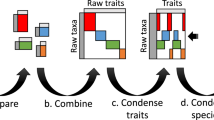Abstract
Trait-based microbial biogeography provides a path for the mechanistic understanding of relationships between microbial diversity and ecosystem functioning. In this mini-review, we identify the scenarios in which to use traits to characterize the microbial community and propose a simple trait-based conceptual framework to link microbial communities with ecosystem functions.

Similar content being viewed by others
References
Aßhauer KP, Wemheuer B, Daniel R and Meinicke P 2015 Tax4Fun: predicting functional profiles from metagenomic 16S rRNA data. Bioinformatics 31 2882–2884
Allison SD and Martiny JB 2008 Resistance, resilience, and redundancy in microbial communities. Proc. Natl. Acad. Sci. USA 105 11512–11519
Byrnes JE, Gamfeldt L, Isbell F, Lefcheck JS, Griffin JN, Hector A, Cardinale BJ, Hooper DU, Dee LE and Emmett DJ 2014 Investigating the relationship between biodiversity and ecosystem multifunctionality: challenges and solutions. Methods Ecol. Evol. 5 111–124
Cadotte MW 2017 Functional traits explain ecosystem function through opposing mechanisms. Ecol. Lett. 20 989–996
Colombo F, Macdonald CA, Jefferies TC, Powell JR and Singh BK 2016 Impact of forest management practices on soil bacterial diversity and consequences for soil processes. Soil Biol. Biochem. 94 200–210
Delgado-Baquerizo M, Maestre FT, Reich PB, Jeffries TC, Gaitan JJ, Encinar D, Berdugo M, Campbell CD and Singh BK 2016 Microbial diversity drives multifunctionality in terrestrial ecosystems. Nat. Commun. 7 10541
Delgado‐Baquerizo M, Powell JR, Hamonts K, Reith F, Mele P, Brown MV, Dennis PG, Ferrari BC, Fitzgerald A, Young A, Singh BK and Bissett A 2017 Circular linkages between soil biodiversity, fertility and plant productivity are limited to topsoil at the continental scale. New Phytol. 215 116–196
Gamfeldt L, Hillebrand H and Jonsson PR 2008 Multiple functions increase the importance of biodiversity for overall ecosystem functioning. Ecology 89 1223–1231
Green JL, Bohannan BJM and Whitaker RJ 2008 Microbial biogeography: From taxonomy to traits. Science 320 1039–1043
Jing X, Sanders NJ, Shi Y, Chu HY, Classen AT, Zhao K, Chen LT, Shi Y, Jiang YX and He J-S 2015 The links between ecosystem multifunctionality and above-and belowground biodiversity are mediated by climate. Nat. Commun. 6 8159
Krause S, Le Roux X, Niklaus PA, Van Bodegom PM, Lennon JT, Bertilsson S, Grossart H-P, Philippot L and Bodelier PLE 2014 Trait-based approaches for understanding microbial biodiversity and ecosystem functioning. Front. Microbiol. 5 251
Louca S, Ploz MF, Mazel F, Albright MBN, Huber JA, O’Connor MI, Ackermann M, Hahn AS, Srivastava DS, Crowe SA, Doebeli M and Parfrey LW 2018 Function and functional redundancy in microbial systems. Nat. Ecol. Evol. 2 936–943
Martiny AC, Treseder K and Pusch G 2013 Phylogenetic conservatism of functional traits in microorganisms. ISME J. 7 830–838
Martiny JBH, Jones SE, Lennon JT and Martiny AC 2015 Microbiomes in light of traits: A phylogenetic perspective. Science 350 aac9323
Nazaries L, Pan Y, Bodrosy L, Baggs EM, Millard P, Murrell JC and Singh BK 2013 Microbial regulation of biogeochemical cycles: evidence form study on methane flux and land-use type. Appl. Environ. Microbiol. 79 4031–4040
Nguyen NH, Song Z, Bates ST, Branco S, Tedersoo L, Menke J, Schilling JS and Kennedy PG 2016 FUNGuild: an open annotation tool for parsing fungal community datasets by ecological guild. Fungal Ecol. 20 241–248
Schamalenberger A, Hodge S, Bryant A, Hawkesford MJ, Singh BK and Kertesz MA 2008 The role of Variovorax and other Commanadaceae in sulfur transformation by microbial wheat rhizosphere communities exposed to different sulphur fertilisation regimes. Environ. Microbiol. 10 1486–1500
Trivedi P, Delgado-Baquerizo M, Trivedi C, Hu H, Anderson IC, Jeffries TC, Zhou J and Singh BK 2016 Microbial regulation of the soil carbon cycle: evidence from gene–enzyme relationships. ISME J. 10 2593–2604
Zhang L-M, Hu H-W, Shen J-P and He J-Z 2012 Ammonia-oxidizing archaea have more important role than ammonia-oxidizing bacteria in ammonia oxidation of strongly acidic soils. ISME J. 6 1032–1045
Acknowledgements
JTW is funded by the National Key R&D Program (2017YFD0800604) and NSFC (41601256), and BKS and EE are funded by CRC-CARE and the Australian Research Council (DP170104634).
Author information
Authors and Affiliations
Corresponding authors
Rights and permissions
About this article
Cite this article
Wang, JT., Egidi, E., Li, J. et al. Linking microbial diversity with ecosystem functioning through a trait framework. J Biosci 44, 109 (2019). https://doi.org/10.1007/s12038-019-9928-9
Published:
DOI: https://doi.org/10.1007/s12038-019-9928-9




